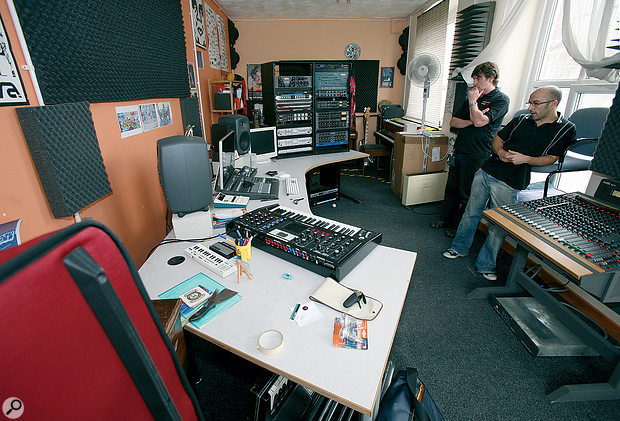 At the start of the Studio SOS visit, Paul and Hugh were confronted with a room that bore more resemblance to a store-room than a studio!
At the start of the Studio SOS visit, Paul and Hugh were confronted with a room that bore more resemblance to a store-room than a studio!
Even with access to the best gear, and commercial experience under your belt, paying attention to your studio's acoustics can still pay massive dividends...
Keyboard player Andrew Kingslow has already enjoyed some commercial success both in the live and recorded music world and in TV music, but he called us in because of monitoring and ergonomic problems in his studio, which is set up in a rented industrial space in the city of Manchester.
The room measures approximately 25 x 11 feet, with a nine-foot high ceiling, and when we arrived, the recording system, based around Apple's Logic Pro 9, was set up on a pair of very substantial office desks facing across the width of the room. Andrew had a pair of Genelec 8050A monitors placed alongside a pair of Yamaha MSP5s, all of which were set on concrete blocks, and augmented by a Yamaha subwoofer fed from a separate output on his Mackie Big Knob monitoring controller (so that he could mute it independently).
Andrew seems unable to resist the lure of vintage keyboards (a Rhodes Suitcase 88, Clavinet C, Wurlitzer EP200, Hammond L100 and Leslie 145, Roland Juno 6, Moog Voyager, Nord Stage 88 Roland SH5, and a Hammond C3 were all present!), so his studio had rapidly been turning into more of a store room than a working space. His impressive collection of outboard gear (including some lovely Manley, Al Smart, Empirical Labs and Avalon gear, as well as a Lexicon 480 and LARC remote) occupied some five different rack units, four of which were stacked up on his desk. All of it was making us look very envious indeed! Andrew had also just taken delivery of a pair of ATC active SCM50A studio monitors, which he wanted to use in place of the Genelecs — but the SCM50s are physically much larger and clearly not suited to desktop mounting.
A La Mode
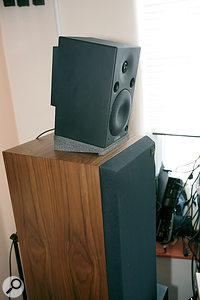 It's important that your speakers are correctly angled (whether downwards, in this case, or upwards if placed on a low surface) to tilt towards your ears at the listening position.
It's important that your speakers are correctly angled (whether downwards, in this case, or upwards if placed on a low surface) to tilt towards your ears at the listening position.
Aside from the general lack of room to swing even a modestly-sized cat without hearing 'meow... thud' with each revolution, Andrew had noticed a very 'hot' room resonance at 110Hz, which meant that every bass note pitched at 'A' set the room modes booming. As he rather likes writing songs in the key of A, this was clearly a disadvantage, and he'd discovered that making a mix sound right in the room made it sound wrong everywhere else! Andrew had applied some ad hoc acoustic treatment in the form of thin foam, but he'd also made up some deeper wedges using salvaged polyurethane packing foam from a flightcase company elsewhere in the same building. That kind of foam has a closed cell structure and so offers little absorbency, though it's possible that it could provide some useful diffusion — particularly with the 'sculptures' he'd fashioned from it.
We discussed the possibilities over a cuppa while listening to some music playback, which confirmed the severity of the room resonance issue. The room dimensions were clearly responsible for the resonance, but working across the room only emphasised the problem — so we suggested reassembling the studio with speakers firing down the length of the room, in the hope that this would improve the bass-boom situation. This would mean adding a little more acoustic foam to damp out the mirror points, but that would be easy enough with some simple Auralex panels. More problematic was the task of fitting everything into the available space in a way that would make it usable.
To make the challenge really interesting, Andrew had also just acquired an old Amek BCIII broadcast mixing console, which he planned to plumb into the system, and which would need to be reachable from the mixing position. There was also a side door to a small vocal booth right next to where the mixing desk would need to be placed, and we'd need to leave access to that too.
As it turned out, the rather thin acoustic-foam lining of the vocal both made it sound too boxy for serious vocal work, but it proved ideal for recording guitar amps. Andrew decided that it would be OK to record vocals in the main room, using an SE Reflexion Filter and pop screen that we'd brought along, courtesy of Sonic Distribution. As long as the singer is far enough from the computer and its uninterruptable power-supply fans, and has his or her back to a foam wall-panel or other absorbent surface, the results should be far less coloured-sounding with this configuration. Later in the day, Hugh assembled the heavy SE mounting hardware in our favoured non-standard way (/sos/may09/articles/qa0509_2.htm) to get more weight over the centre of gravity of the mic stand.
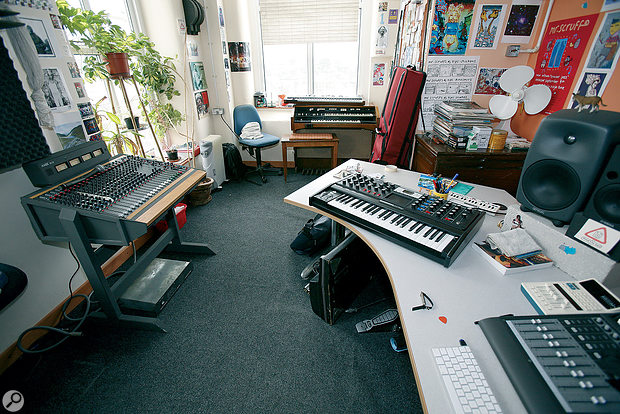 By the time we'd reached the bottom of our first cup of tea, we'd all reached the same conclusion: the task ahead was impossible — but we'd have a go anyway! Because of the amount of heavy gear, the job might have been better suited to a removal company, but we figured that if we got rid of one of the office desks we'd be in with a chance. Excess packing boxes, chairs and other pieces of furniture were pushed out of the studio door to make a little more space and we set to work, Hugh's first task being to disconnect the wiring between rack units, adding labels to the various connectors, so that we could move them off the desk.
By the time we'd reached the bottom of our first cup of tea, we'd all reached the same conclusion: the task ahead was impossible — but we'd have a go anyway! Because of the amount of heavy gear, the job might have been better suited to a removal company, but we figured that if we got rid of one of the office desks we'd be in with a chance. Excess packing boxes, chairs and other pieces of furniture were pushed out of the studio door to make a little more space and we set to work, Hugh's first task being to disconnect the wiring between rack units, adding labels to the various connectors, so that we could move them off the desk.
The whole process was a bit like one of those children's puzzles where you have an empty square and you have to somehow slide all the other squares around to make a picture... The main difference was that most of the time we didn't seem to have an empty square, and the pieces took three people to lift (especially the piano and organ)!
Andrew's room has three windows along the long right-hand side, with deep window ledges set a couple of feet up from the floor, so I suggested we try to fit all the necessary rack gear into just three of the racks and put those in the centre window space, with some extra support for the few inches of overhanging rack box (since most of the weight was towards the front of the rack frames, of course).
The ATC speakers came with strong metal stands for domestic applications. As these were not tall enough for our monitoring needs, we used them with concrete blocks sitting on top as supports for the front of the racks. By using the window space, we were able to keep the racks out of the way and still have them reasonably accessible. Unfortunately, they weren't easily reachable from the new desk position there, so we suggested that Andrew could eventually get some custom rack cases made, with sloping fronts that would enable him to have key pieces of gear under his computer desk and/or the Amek mixer, with perhaps a 4U case made to sit on top of the desk under the computer monitor for his mastering processors.
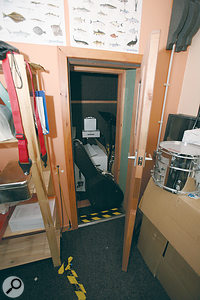 This small cupboard wasn't suitable for its intended purpose as a vocal booth, but worked fine for recording guitar cabs.Our reshuffle (and a bit of judicious rack-space reallocation) left two sturdy and suitably tall rack cases empty and free to be used as stands for the ATC monitors (while also housing some equipment to which Andrew didn't need instant access, such as the Amek power supply, the Lexicon mainframe, and so on). That would suffice until some more suitable stands could be bought or fabricated, so we set these up behind the desk ,with the Yamaha MS5s on top of the ATCs and supported by angled foam wedges with a square of non-slip matting on top to get them aiming directly at the listening position. (We'd normally use Auralex MoPads for this purpose but we'd run out and had to improvise!) We used the same non-slip matting under the ATC monitors.
This small cupboard wasn't suitable for its intended purpose as a vocal booth, but worked fine for recording guitar cabs.Our reshuffle (and a bit of judicious rack-space reallocation) left two sturdy and suitably tall rack cases empty and free to be used as stands for the ATC monitors (while also housing some equipment to which Andrew didn't need instant access, such as the Amek power supply, the Lexicon mainframe, and so on). That would suffice until some more suitable stands could be bought or fabricated, so we set these up behind the desk ,with the Yamaha MS5s on top of the ATCs and supported by angled foam wedges with a square of non-slip matting on top to get them aiming directly at the listening position. (We'd normally use Auralex MoPads for this purpose but we'd run out and had to improvise!) We used the same non-slip matting under the ATC monitors.
Auralex foam was applied to the left and right walls at the mirror points, one piece having to be curved around the edge of the window opening, with a further panel stuck to the front wall to extend the area of the foam that Andrew had already fitted.
Piano Movers!
We arranged the piano, Hammond and Leslie along the left wall, with the Juno 6 perched on top of the Hammond. The Moog Voyager fitted onto the end of the curved computer desk, where Andrew could play it. That still left room between the left-hand end of the desk and the wall to reach the booth door, and some space to the right of the desk to accommodate another shelf unit for Andrew's second LCD monitor screen (which normally displays his software's Mix window).
The Amek desk was set up sideways‑on to the mixing position, on the right wall, again easily accessible, and adjacent to the 'Mix screen' LCD, which seemed to make sense. As we'd moved all the monitor speakers off the desk, there was now plenty of room for the Mackie Big Knob monitor controller and the Mackie Control, as well as the computer screens, computer keyboard, external hard drives and so on.
 Moving Andrew's keyboards, including his piano, Hammond organ and Roland Juno 6 to the spot that had been his mix position made them much more accessible for daily use.The remaining keyboards went to the back of the room and around the rear of the right-hand wall, which was an area that Andrew had already identified as being a good place to record electro-acoustic instruments and drums. The finishing touch (apart from introducing a vacuum cleaner to the room), was to glue a wooden strip to the end of one of the spare pieces of foam, so that Andrew could hang it on a mic stand behind the singer when recording vocals (with the Reflexion Filter in front).
Moving Andrew's keyboards, including his piano, Hammond organ and Roland Juno 6 to the spot that had been his mix position made them much more accessible for daily use.The remaining keyboards went to the back of the room and around the rear of the right-hand wall, which was an area that Andrew had already identified as being a good place to record electro-acoustic instruments and drums. The finishing touch (apart from introducing a vacuum cleaner to the room), was to glue a wooden strip to the end of one of the spare pieces of foam, so that Andrew could hang it on a mic stand behind the singer when recording vocals (with the Reflexion Filter in front).
The big gear reshuffle was going to leave Andrew with a lot of repatching to do of the gear and patchbay in his rack cases, and he was still working out how best to integrate his Amek mixer into the system. Furthermore, a package containing an SSL MADI PCI card and AlphaLink MADI interface arrived while we were working, as Andrew wanted to expand the input channel count beyond what he was currently getting from his Apogee Rosetta interface.
It was clear we couldn't get the whole setup totally rewired and working in the couple of hours that remained to us. Andrew said that he was happy to look after the repatching once he'd figured out the best way to do it, so we just got his core system up and running, using the Rosetta and the Mac connected to the Big Knob and the two sets of monitors.
 The obligatory 'after' shot. You can see that not only did we put up more Auralex foam to tame unwanted reflections and tighten the stereo imaging, but turned the whole studio around so the speakers fired down the longer axis of the room. We also removed as much clutter as we could, to create a much more pleasant and practical environment.
The obligatory 'after' shot. You can see that not only did we put up more Auralex foam to tame unwanted reflections and tighten the stereo imaging, but turned the whole studio around so the speakers fired down the longer axis of the room. We also removed as much clutter as we could, to create a much more pleasant and practical environment.
Subwoofer
We placed the Yamaha subwoofer close to the wall between the ATC monitors, but well off-centre, and made further adjustments to its position while listening to some test tracks to find the location where the bass seemed most even. We also routed the signals to the little MSP5s through the subwoofer, to take advantage of its built-in crossover filters, and dropped the sub's level to optimise the balance between subwoofer and satellite speakers. Working in this way meant that Andrew could no longer switch the subwoofer off from the Big Knob controller, but it allowed the MSP5s to integrate with the sub better, and go louder and cleaner. Although the room still had a tendency to emphasise that bottom 'A', the resonance problem at the new monitoring position was much less pronounced, and the stereo imaging was significantly better once we'd added the extra Auralex. Switching to the ATCs and adjusting levels so that both monitors were nominally at the same loudness, the mid-range took on an extra dimension and, again, the imaging was much more spacious, but still stable and solid. We also adjusted the distance between the ATCs and the rear wall, for the smoothest low-end performance. Andrew was very pleased with the smooth, yet detailed sound he was hearing from these speakers, and by the significant improvement in the intensity of the room bump.
The rest of our time was spent tidying away as much of the smaller gear as we could and vacuuming the carpet as we moved things around. The end result seemed far more spacious than before, with a much more open feel. Now Andrew could set up a drum kit to record at the far end of the room if necessary, and there was also space for him to have most of his keyboards set up at the same time. During the course of the day, several of Andrew's musician friends dropped by and most seemed surprised by the ongoing transformation from negative TARDIS (more stuff than space to put it in!) to a friendly and open working space. By the time we left, Andrew seemed very happy with the changes, and even the prospect of all that rewiring didn't seem to daunt him.
Reader Reaction
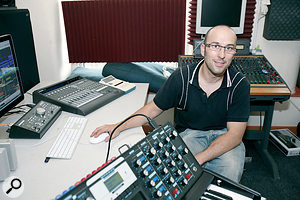 SOS reader Andrew Kingslow in his revamped studio.Andrew: "My initial impression after the switch-around was how good the ATCs sounded... but, rather embarrassingly, Hugh pointed out that I was listening to my old Yamahas! They really did sound that much better than before.
SOS reader Andrew Kingslow in his revamped studio.Andrew: "My initial impression after the switch-around was how good the ATCs sounded... but, rather embarrassingly, Hugh pointed out that I was listening to my old Yamahas! They really did sound that much better than before.
"Although the bass is still a little lumpy (unavoidable, given the room dimensions), I have since invested in four GIK Acoustics bass traps (two Monster Traps and two 244s) and these, placed in the corners and back wall behind my speakers, have further improved the tightness of the bass end. After placing the Auralex on the side walls, it really was amazing how my stereo image stabilised: vocals were just sitting slap-bang between the speakers. The Genelecs have been swapped for about half a mile of cable to plug the desk in, and the racks have been positioned closer to my mixing position.
"All in all, I would say the move has proved most successful and I am very much looking forward to hearing how my new mixes will translate on other systems. Many thanks to the Studio SOS Team for their expertise and handy skills!”
